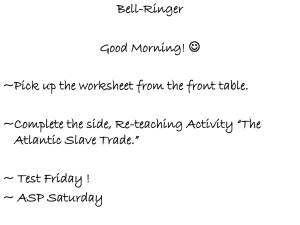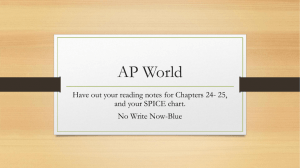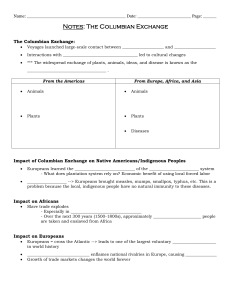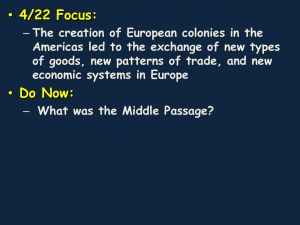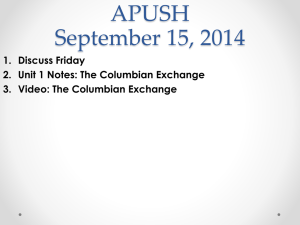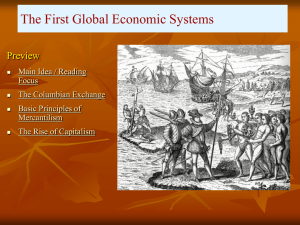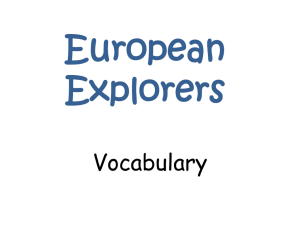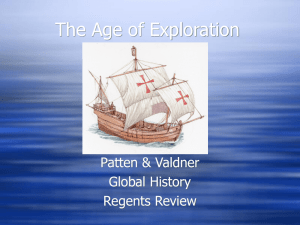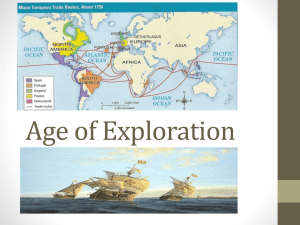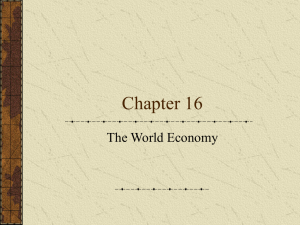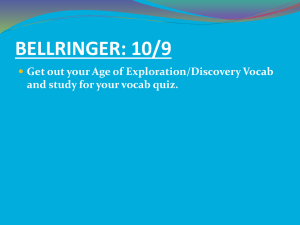Chapter 20: Science and Exploration
advertisement
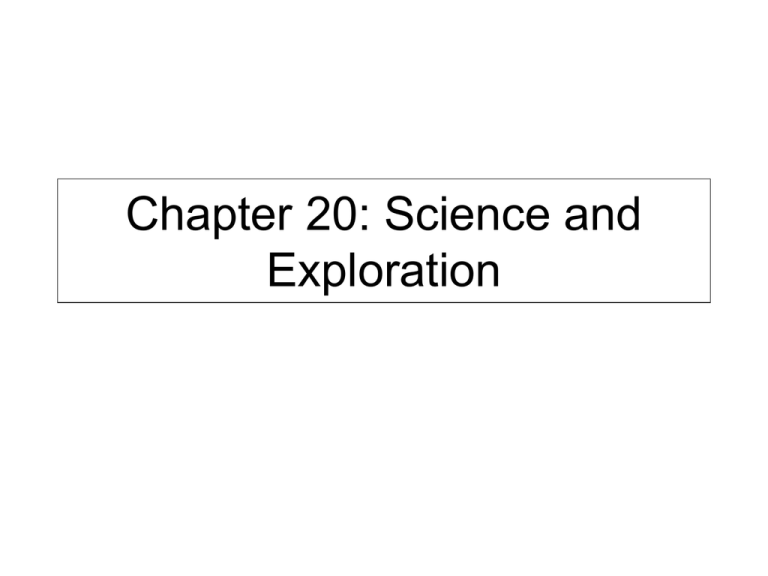
Chapter 20: Science and Exploration Bell Work (10 Minutes) 4/8 Write a paragraph answering one of the following: 1. How did ideas and inventions of the Renaissance and Reformation change Europe between the 1300s-1600s? 2. Beginning in the late 15th century, how did the Scientific Revolution lead to exploration and founding a New World? What is the Scientific Revolution? What is the Age of Exploration? Columbian Exchange Mercantilism Capitalism New Systems of Trade The Big Idea Exchanges between the Old World and the New World influenced the development of new economic systems: mercantilism and capitalism. Main Ideas • Europe, Asia, Africa, and the Americas exchanged plants, animals, and ideas. • In the 1600s and 1700s, new trade patterns developed, and power shifted in Europe. • Market economies changed business in Europe. Main Idea 1: Europe, Asia, Africa, and the Americas exchanged plants, animals, and ideas. Columbian Exchange • The exchange of plants, animals, and ideas between the New World (the Americas) and the Old World (Europe) is known as the Columbian Exchange. • Exchanges occurred when Europeans took seeds to plant crops in the New World. • Europeans also took animals such as cows, goats, sheep, horses, and chickens to the New World. • Accidental exchanges took place when Europeans brought over diseases or animals such as rats that hid in ships. Columbian Exchange The New World The Old World New World Plants and Animals • While Europeans introduced plants and animals to the New World, they also found things they had not known about. • They took samples back to their home countries as well as to Africa and Asia. • Vegetables such as tomatoes, potatoes, and squash as well as plants such as tobacco had never been seen before. • These products went around the world. Many of them grew well in other countries, so they are now a part of those cultures. Exchanges of Culture • Europeans introduced their culture to the places they explored. • Christians set out to convert people in the new lands to their religion. • Missionaries also taught European languages to the native peoples. Exchanges of Technology • Europeans took guns and steel to parts of Africa and to the Americas. • The introduction of sheep and sugarcane created new industries. • People began to grow sugarcane on plantations, or large farms. Treatment of Native Americans • Plantations and mines made money for Portugal, Spain, and some colonists in the Americas. • However, the plantation life and mining made for bad treatment of Native Americans. • The Spanish colonists forced Native Americans to work on the plantations. Hard work and disease killed many. • Europeans then started using enslaved Africans as workers. – Soon, thousands of Africans were being shipped to the Americas as slave labor, and this continued until the late 1800s. Main Idea 2: In the 1600s and 1700s, new trade patterns developed, and power shifted in Europe. • Mercantilism is a system in which a government controls all economic activity in a country and its colonies to make the government stronger and richer. • Mercantilism was the main economic policy in Europe between 1500 and 1800. • Governments did everything they could to get more gold and silver. • Countries tried to export more goods than they imported to keep a favorable balance of trade. New Trading Patterns • One major trading pattern involved the exchange of raw materials, manufactured products, and slaves among Europe, Africa, and the Americas. This type of trade was called triangular trade. • The Atlantic slave trade was a major part of the trade network. • Enslaved Africans were crammed onto ships and sent mainly to South America and the Caribbean. • Between the 1500s and 1600s, millions of slaves were shipped to the colonies in the New World. The Shift of Power • Portugal and Spain were leading economic powers in the 1500s, but that changed as the Dutch and English became stronger. • The Netherlands became a great trading power when Dutch merchants formed a company that traded directly with Asia. • England benefited greatly from increased trade with China and India as well as with North America. Banking • The Dutch and English set up banks due to increased trade. • Banking improved business. – Merchants could exchange money from different countries and get the correct value. – Money was loaned to people to start new businesses, which contributed to economic growth. Market Economies • The growth of manufacturing economies was caused by increased demand for goods. • Demand was increased by a growing population, lower expenses for food, and more colonies. • As demand grew, businesspeople tried to find new and better ways to produce their goods. They wanted to increase their supply to meet the demand. Capitalism and Market Economies • Capitalism is an economic system in which individuals and private businesses run most industries. Competition among these businesses affects the cost of goods. • Competition works best in a market economy, in which individuals decide what goods and services they will buy. • In the 1800s, capitalism became the economic system of most countries in the world. Quick Questions 5 Minutes 1. 2. 3. 4. 5. What was the Columbian Exchange? Explain the power shift. Explain supply and demand. What is capitalism? What is a market economy? Quick Questions 1. What was the Columbian Exchange? • 2. The exchange of plants, animals, and ideas between the New World (the Americas) and the Old World (Europe) Explain the power shift. • 3. From Portugal and Spain (colonies) to Netherlands and England (banks/companies) Explain supply and demand. • 4. Population grew, needed more supply, people produced supply to meet the demand What is capitalism? • 5. Individual/private run the industry; businesses compete which affect cost of goods What is a market economy? • Individuals decide what goods and services they will buy; competition works best in this type of economy Page: 598 Study Island • TCAP Review – #1(Open today and close Sunday) – #2 (Open Friday and close Next Friday) • • • • Must Answer/Master at least 70 questions Answer at least 10 in each section; there are 7 sections. Not timed You are encouraged to do as many questions as allowed. Extra credit may be given to those who master the maximum amount of questions. http://www.studyisland.com/web/index/ TCAP Pre-Test • Name • Goal: My Projected Mastery is ____. I project this because _________________. • Actual Mastery: ____ • 1-69 Write the letter of the correct answer. Answers will either be ABCD or FGHJ ________________________________________ • Turn Test and Answers in when finished • Work on Study Island or Essential Questions
